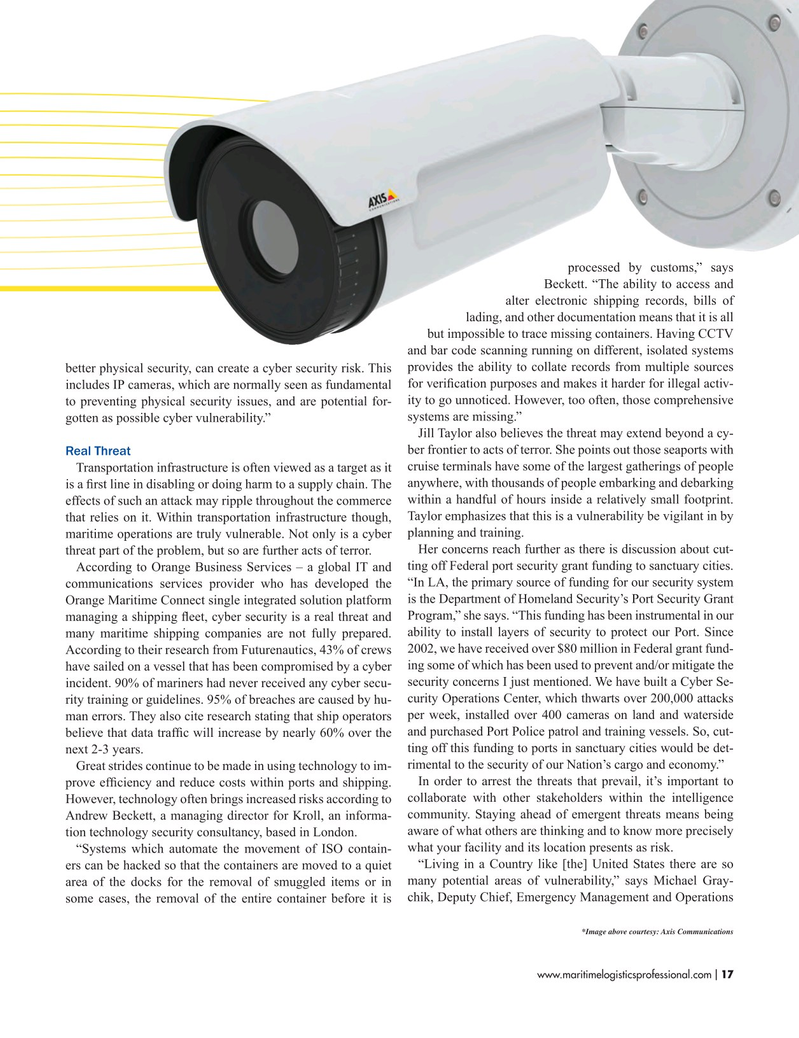
Page 17: of Maritime Logistics Professional Magazine (Jul/Aug 2017)
PORTS & INFRASTRUCTURE
Read this page in Pdf, Flash or Html5 edition of Jul/Aug 2017 Maritime Logistics Professional Magazine
processed by customs,” says
Beckett. “The ability to access and alter electronic shipping records, bills of lading, and other documentation means that it is all but impossible to trace missing containers. Having CCTV and bar code scanning running on different, isolated systems better physical security, can create a cyber security risk. This provides the ability to collate records from multiple sources includes IP cameras, which are normally seen as fundamental for verifcation purposes and makes it harder for illegal activ- ity to go unnoticed. However, too often, those comprehensive to preventing physical security issues, and are potential for- gotten as possible cyber vulnerability.” systems are missing.”
Jill Taylor also believes the threat may extend beyond a cy- ber frontier to acts of terror. She points out those seaports with
Real Threat
Transportation infrastructure is often viewed as a target as it cruise terminals have some of the largest gatherings of people is a frst line in disabling or doing harm to a supply chain. The anywhere, with thousands of people embarking and debarking effects of such an attack may ripple throughout the commerce within a handful of hours inside a relatively small footprint. that relies on it. Within transportation infrastructure though, Taylor emphasizes that this is a vulnerability be vigilant in by maritime operations are truly vulnerable. Not only is a cyber planning and training.
threat part of the problem, but so are further acts of terror. Her concerns reach further as there is discussion about cut-
According to Orange Business Services – a global IT and ting off Federal port security grant funding to sanctuary cities. communications services provider who has developed the “In LA, the primary source of funding for our security system
Orange Maritime Connect single integrated solution platform is the Department of Homeland Security’s Port Security Grant managing a shipping feet, cyber security is a real threat and Program,” she says. “This funding has been instrumental in our many maritime shipping companies are not fully prepared. ability to install layers of security to protect our Port. Since
According to their research from Futurenautics, 43% of crews 2002, we have received over $80 million in Federal grant fund- have sailed on a vessel that has been compromised by a cyber ing some of which has been used to prevent and/or mitigate the incident. 90% of mariners had never received any cyber secu- security concerns I just mentioned. We have built a Cyber Se- curity Operations Center, which thwarts over 200,000 attacks rity training or guidelines. 95% of breaches are caused by hu- man errors. They also cite research stating that ship operators per week, installed over 400 cameras on land and waterside believe that data traffc will increase by nearly 60% over the and purchased Port Police patrol and training vessels. So, cut- next 2-3 years. ting off this funding to ports in sanctuary cities would be det- rimental to the security of our Nation’s cargo and economy.”
Great strides continue to be made in using technology to im-
In order to arrest the threats that prevail, it’s important to prove effciency and reduce costs within ports and shipping. collaborate with other stakeholders within the intelligence
However, technology often brings increased risks according to community. Staying ahead of emergent threats means being
Andrew Beckett, a managing director for Kroll, an informa- aware of what others are thinking and to know more precisely tion technology security consultancy, based in London. “Systems which automate the movement of ISO contain- what your facility and its location presents as risk. “Living in a Country like [the] United States there are so ers can be hacked so that the containers are moved to a quiet area of the docks for the removal of smuggled items or in many potential areas of vulnerability,” says Michael Gray- some cases, the removal of the entire container before it is chik, Deputy Chief, Emergency Management and Operations *Image above courtesy: Axis Communications www.maritimelogisticsprofessional.com 17
I

 16
16

 18
18
